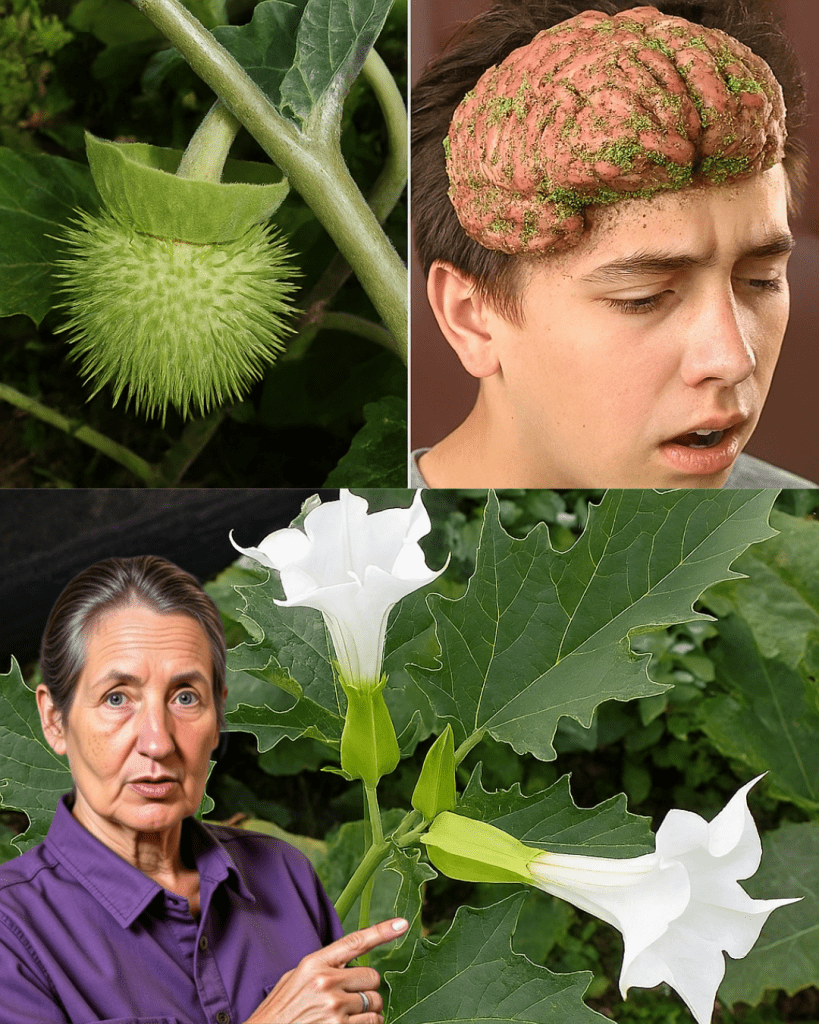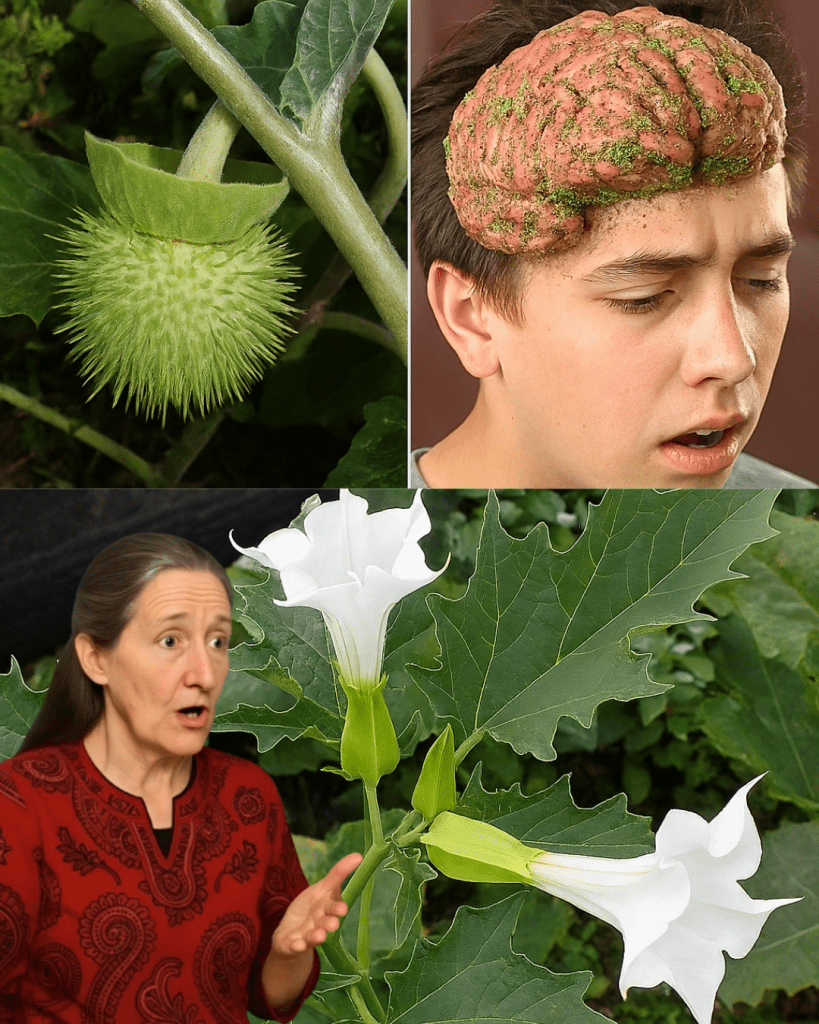Picture this: you’re strolling through a garden, captivated by a cluster of elegant, trumpet-shaped flowers glowing under the moonlight. Their sweet fragrance pulls you closer, and their spiky seed pods add an intriguing, almost mystical charm. But beneath this enchanting exterior lies a dangerous secret. Datura stramonium, known as jimsonweed, thorn apple, or devil’s trumpet, is one of nature’s most deceptive creations—a plant as toxic as it is beautiful. Whether you’re a gardener, a parent, a pet owner, or simply someone who loves exploring nature, knowing how to identify and safely handle this plant could save a life. Let’s uncover the allure, dangers, and essential precautions of Datura stramonium to keep you and your loved ones safe.

The Allure of Datura Stramonium
🌸 A Botanical Beauty
Datura stramonium, a member of the nightshade family (Solanaceae), is a fast-growing annual that commands attention. Native to North and Central America, it has spread across the globe, thriving in temperate and tropical regions. You’ll find it along roadsides, in empty lots, or even sneaking into your garden, often carried by birds scattering its seeds. Its striking appearance—large, fragrant flowers and spiky, walnut-sized seed pods—makes it a favorite for some ornamental gardeners, but its beauty comes with a steep price.
🌿 A Plant with a Storied Past
For centuries, Datura stramonium has woven itself into human history. Ancient cultures, from the Americas to India, used it in spiritual rituals and traditional medicine for ailments like asthma, pain, and insomnia. In Hinduism, it’s linked to Shiva, symbolizing transformation through its potent effects. But its use was always approached with caution, as even small doses could tip from healing to harmful. Today, modern medicine strongly discourages its use due to its unpredictable toxicity.
Identifying Datura Stramonium: Know What to Look For
🔍 Key Characteristics
Spotting Datura stramonium is the first step to staying safe. Here’s how to recognize it:
- Height: Grows 2–6 feet tall, with a bushy, sprawling habit.
- Leaves: Large (3–8 inches), dark green, with jagged, toothed edges and a foul odor when crushed.
- Flowers: Trumpet-shaped, 3–6 inches long, white to pale purple, fragrant at night, and blooming from summer to fall.
- Seed Pods: Round, spiky capsules (thorn apples) that split open when ripe, releasing dozens of small, black seeds.
- Habitat: Thrives in disturbed soils—roadsides, fields, gardens, or waste areas.
🌱 Why It’s Tricky
Datura’s flowers can be mistaken for harmless look-alikes like moonflowers (Ipomoea alba) or even pumpkin flowers, leading to accidental poisonings when used in food, like in a case where a family mistook it for an edible plant in a traditional dish. Its seeds resemble tomato seeds, adding to the confusion. Awareness is key to avoiding these dangerous mix-ups.
The Deadly Danger of Datura Stramonium
☠️ Toxic Tropane Alkaloids
Every part of Datura stramonium—seeds, leaves, flowers, and roots—contains potent tropane alkaloids: atropine, scopolamine, and hyoscyamine. These chemicals disrupt the central and peripheral nervous systems, causing a condition known as anticholinergic syndrome. Even a small amount—such as a few seeds—can trigger severe symptoms, and the plant’s toxicity varies unpredictably based on its age, location, and growing conditions.
🚨 Symptoms of Poisoning
Datura poisoning is no minor issue. Symptoms typically appear 30–60 minutes after ingestion and can last 24–48 hours, or even up to two weeks in severe cases. Common signs include:
- Dilated pupils and blurred vision, often causing painful light sensitivity.
- Dry mouth and difficulty swallowing, leading to intense thirst.
- Rapid heartbeat (tachycardia) and irregular heart rhythms.
- Confusion, agitation, vivid hallucinations, or delirium—often terrifying.
- Fever, flushed skin, and overheating due to impaired sweating.
- Seizures, coma, or, in extreme cases, death.
Children are particularly vulnerable, with cases reported of accidental poisoning from sucking nectar or eating seeds. Pets and livestock, like dogs, cats, and cattle, are also at risk, with ingestion often proving fatal.
🩺 Real-Life Risks
Tragic incidents highlight Datura’s dangers. In 2019, over 200 people in Uganda were poisoned after consuming food contaminated with Datura seeds, experiencing symptoms like convulsions and hallucinations. In another case, a family unknowingly used Datura flowers in a traditional meal, leading to severe poisoning. These incidents underscore the need for vigilance, especially in areas where Datura grows wild.
Who’s Most at Risk?
👶 Children and Pets
Curious kids and animals are drawn to Datura’s colorful flowers and spiky pods, mistaking them for something safe to touch or taste. A 3-year-old in Ethiopia suffered seizures and delirium after ingesting seeds while playing, highlighting the plant’s threat to young explorers.
🌆 Urban Dwellers and Foragers
City residents, less familiar with wild plants, are increasingly at risk as they explore nature or forage for food. Mistaking Datura for an edible plant has led to poisonings, especially among those seeking new flavors or herbal remedies.
🎭 Thrill-Seekers
Teenagers and young adults sometimes intentionally ingest Datura for its hallucinogenic effects, unaware of its dangers. These deliberate ingestions often result in emergency room visits, with symptoms like coma and rhabdomyolysis (muscle breakdown) requiring intensive care.
Safety Precautions: How to Protect Yourself and Others
🧤 Safe Handling and Removal
If you spot Datura stramonium in your garden or property, take immediate action:
- Wear Protective Gear: Use gloves and long sleeves to avoid skin irritation from the plant’s sap, which can cause dermatitis or mild toxicity.
- Remove the Entire Plant: Pull up the roots to prevent regrowth. Do not compost—seal the plant in a trash bag for disposal.
- Wash Thoroughly: Clean your hands, tools, and clothing after handling to avoid accidental exposure.
- Prevent Seed Spread: Remove plants before seed pods mature to stop them from spreading. Burning or burying seeds deeply can prevent germination.
🚨 If Poisoning Is Suspected
If someone ingests or is exposed to Datura, act fast:
- Call emergency services (e.g., 911 in the U.S.) or a poison control center (e.g., 13 11 26 in Australia) immediately.
- Bring a sample of the plant for identification, if safe to do so.
- Do not induce vomiting unless instructed by a professional.
- In severe cases, treatments like activated charcoal, physostigmine, or IV fluids may be used in a medical setting.
📚 Educate Your Community
Share knowledge about Datura’s dangers with family, friends, and neighbors. Teach children and pet owners to avoid touching or tasting unknown plants. Post warnings in community gardens or online forums to raise awareness.

Safer Alternatives for Your Garden
🌺 Beauty Without the Risk
Love the look of trumpet-shaped flowers? Opt for these safe, stunning alternatives:
- Moonflower (Ipomoea alba): Night-blooming, white flowers with a sweet scent, non-toxic.
- Trumpet Vine (Campsis radicans): Vibrant, red-orange blooms that attract hummingbirds.
- Hibiscus: Bold, colorful flowers that are safe and edible.
Note: Be cautious with Brugmansia (angel’s trumpet), as it’s also toxic, though less potent than Datura.
🌱 Keep Your Garden Safe
Regularly inspect your yard for Datura, especially in disturbed soils or areas where birdseed may introduce it. Prevent its growth by mulching, hand-pulling seedlings, or using selective herbicides on young plants before they flower. Persistence is key, as Datura seeds can remain viable in soil for decades.
The Bigger Picture: Respecting Nature’s Power
🌍 A Plant with a Purpose
In nature, Datura stramonium serves a role, deterring herbivores with its foul-smelling leaves and attracting nocturnal pollinators like moths. Its toxicity is a defense mechanism, but its invasiveness and danger to humans and animals make it a plant to approach with respect, not curiosity.
💡 Knowledge Is Protection
Datura stramonium is a stark reminder that beauty in nature can hide serious risks. By learning to identify this plant, understanding its dangers, and taking simple precautions, you can enjoy your garden and outdoor adventures safely. Whether you’re a seasoned gardener or a nature enthusiast, staying informed is your best defense.
✨ Take Action Today
Check your yard, educate your household, and share this knowledge. A little awareness goes a long way in preventing accidental poisonings. Let Datura’s beauty inspire awe—but from a safe distance. Grow smart, stay safe, and keep your garden a sanctuary for all.









